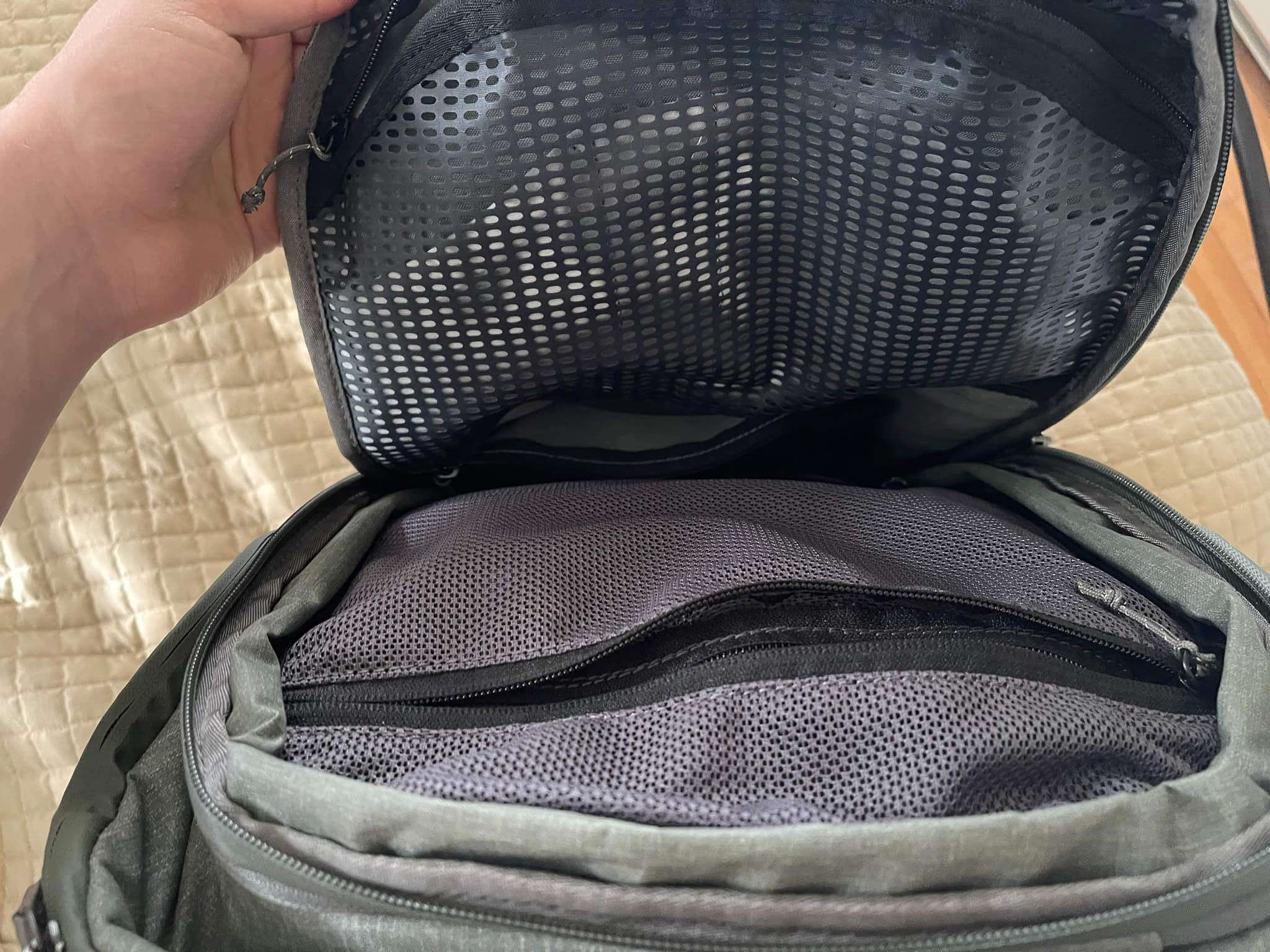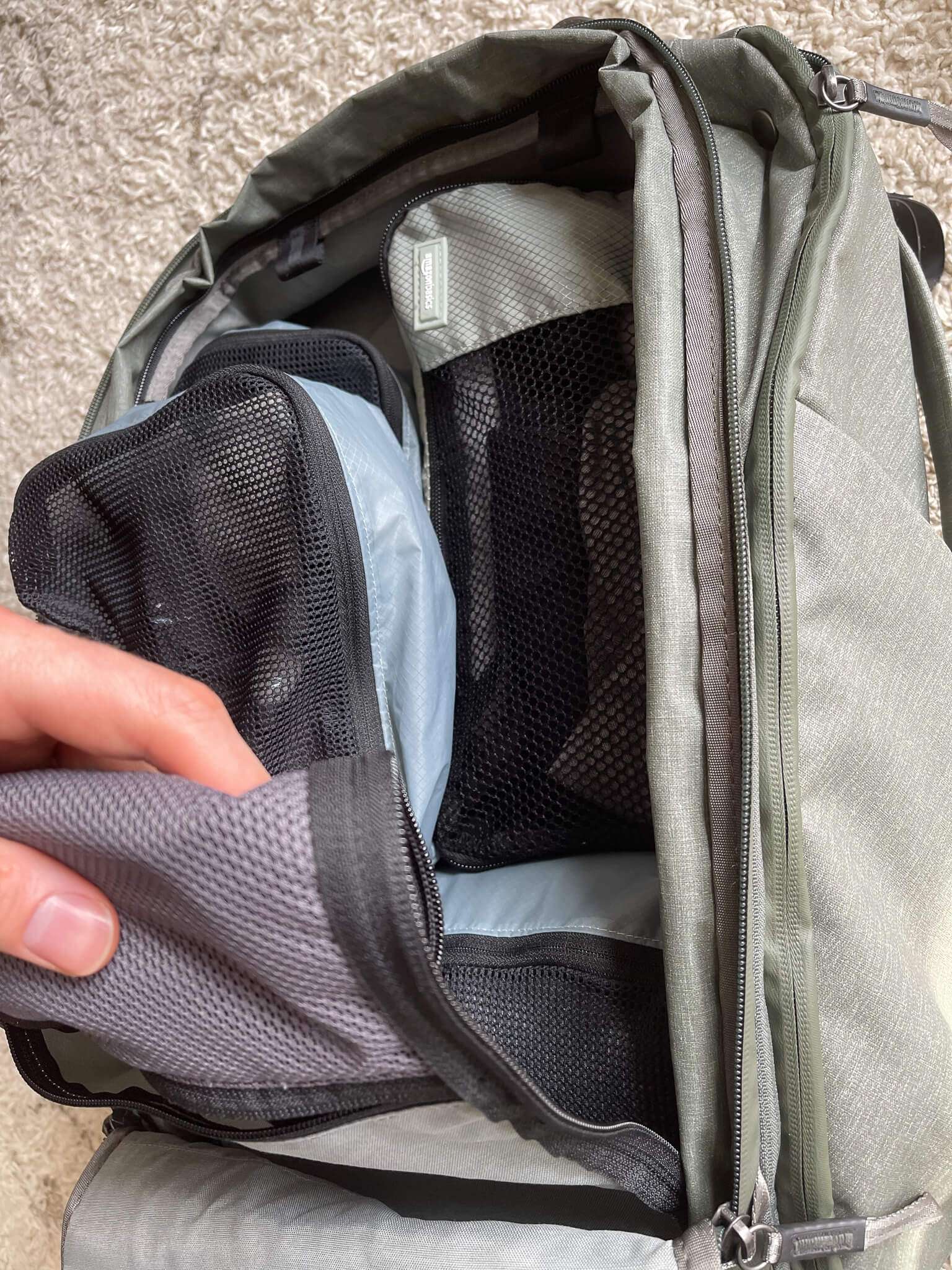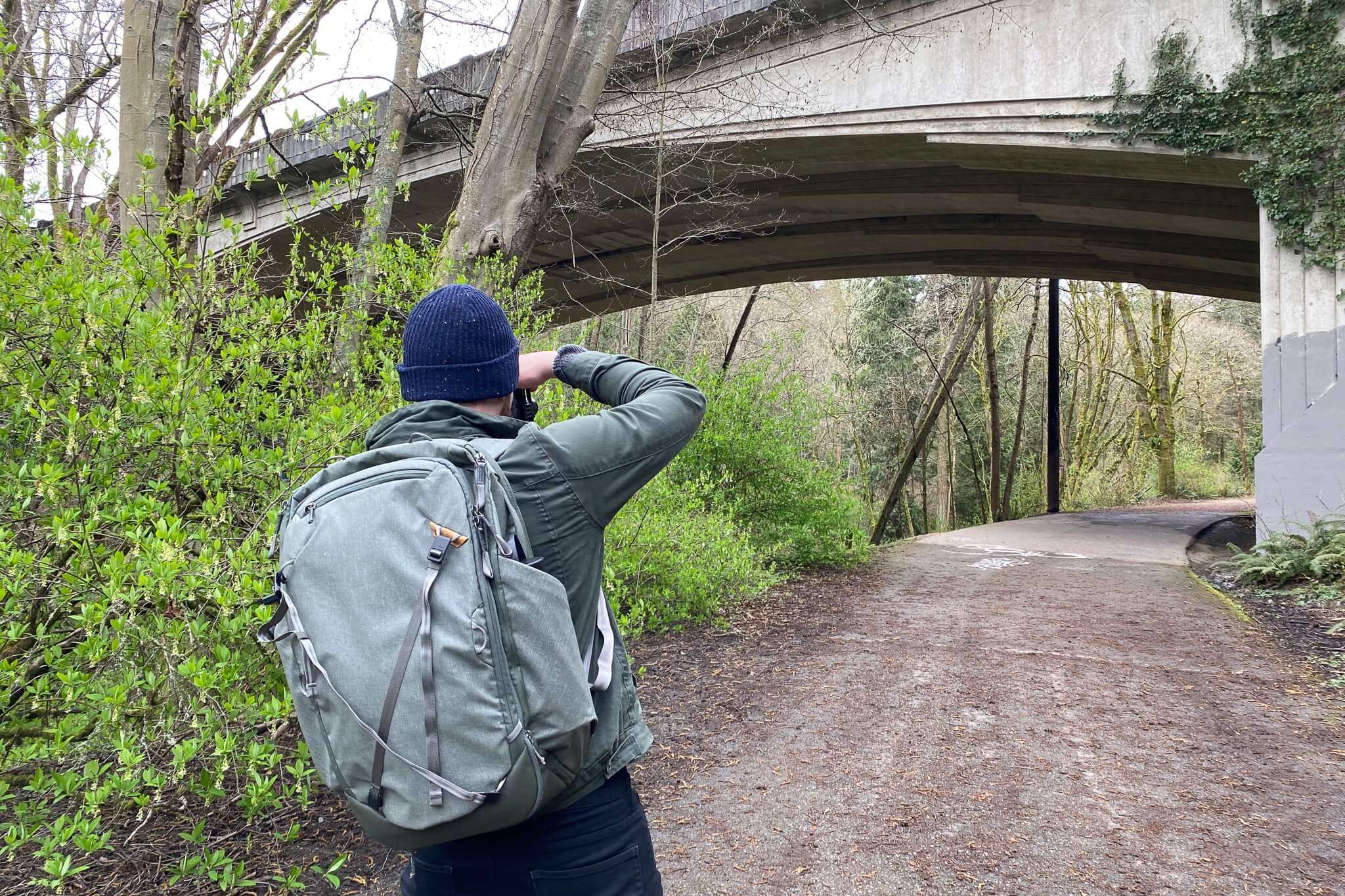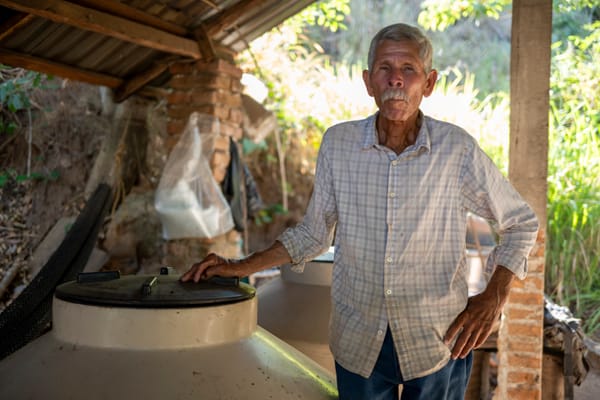Peak Design Travel Backpack Review

Disclaimer: The team at Peak Design sent me this bag to review; however, all opinions are my own.
Summary
The Peak Design Travel Backpack is one of the best travel backpacks you can find. It’s a versatile backpack with expandable storage and multiple carry styles that can help you overcome most of the one-bag or ultralight travel trade-offs.
| Pros | Cons |
|---|---|
| Flexible, expandable storage | Quick access pocket leaves something to be desired |
| Does well as a daily carry option | Heavy compared to similar bags |
| Two big water bottle/stash pockets | Rain fly not included |
| Stow-able shoulder and hip straps | Could use some depth to the internal pockets |
| Great build quality | |
| Excellent accessory ecosystem | |
| Multiple carry options |
Specs
- Standard (max carry-on): 35L
- Compressed: 30L
- Expanded: 45L
- 2.05 kg (4.5 lb)
- Weatherproof 100% recycled 400D nylon canvas external shell. DWR impregnated and double poly coated for water resistance. Sage fabric is Bluesign approved.
- 900D waterproof bottom liner
- High-visibility grey nylon interior
- Hardware is anodized aluminum and glass-reinforced nylon
- Super-durable UltraZips with abrasion-resistant UHMPE thread
- Leather accents (Sage only) are Gold Certified by the Leather Working Group
- Hypalon zip pulls and reinforced stress points
About Peak Design
Peak Design started in 2010 when its founder took a trip worldwide. He realized that carrying a big camera is kind of a pain in the ass, so he made some products to help remedy that issue.
After a Kickstarter launch, Peak Design has turned into a company making some of the best backpacks for photographers and commuters.
Around 2020, they launched the first version of the Peak Design Travel Backpack, aimed at both photographers and travelers alike. Since then, they’ve built a great ecosystem of daily carry and travel accessories that you’ve definitely seen around town.
The Peak Design Travel Backpack
I had seen the first few versions of the Peak Design Travel Backpack. They always seemed enticing, but I unfairly viewed them as a backpack designed for photographers. At the time, that wasn’t me.
Ironically, as the blog has grown and the need for more photography and filmmaking equipment to bring with me on my travels, I started to look for some bags that have been designed with that in mind.
Materials & Aesthetic
I typically go for the grey or black colors for backpacks….some would call that boring; I say it goes with everything and doesn’t get dirty. But to each their own.
But for the Peak Design Travel Backpack, I opted for the Sage color this time around. It’s a nice, light, heather green that is quite nice.
The material they use on this bag is a 400D nylon canvas with a pretty rugged, almost matte feel; on the bottom of a sturdy 900D waterproof material.

In the updated version, the silhouette is a touch more square, which gives it a more modern feel. It’s also pretty streamlined, with not too many straps or things dangling on the sides.
I’d say, in general, it’s a pretty inconspicuous look that can suit most environments.
Outside the bag
This is where it gets interesting; there are just a TON of features on this bag.
The back of the bag has two pretty comfortable, well-padded shoulder straps. There are hip straps on the 45L version of the Peak Design Travel Backpack, which help carry the load when this is fully packed out. Both of these straps, the shoulder and hip straps, can stow away into a panel on the back, which is secured by magnets. One of the better stowing mechanisms I’ve seen on a travel backpack.

If you choose to stow away your straps, there is a handle squarely in the middle of the back panel that you can use to pick up and carry the bag. I’ve never used it this way and am honestly confused by the scenario when I would…maybe when I stow these away for a road trip?
On both sides of the bag are two huge water bottle/stuff pockets that are fantastic to use. These are secured with elastic, so when they aren’t in use, they sit tightly next to the bag, but expand enough to fit large water bottles.

The water bottle pockets get even more interesting when you find there is a hidden zipper pocket on both. I have no idea what the hell you’d put in these pockets, especially when there’s a water bottle or tripod in there.

The front of the bag gets pretty interesting. There is a hidden pocket on the front shell, secured by magnets, that holds two external lash straps that can be used to attach stuff to the outside of the bag. I can’t stress how much I LOVE this feature. I usually strap these to the front of the backpack and use them to hold a jacket, saving me some space on the inside.

There are nicely padded handles on the sides and top of the bag to grab and toss this thing around. And nice beefy zippers so you won’t worry about snagging and can likely keep some water out (though not waterproof).
Pockets
There are about three main pockets on this bag. I say about it because the Peak Design Travel Bag is pretty modular with expanding/collapsing storage.
First, a padded quick access pocket on the front of the bag. In all honesty, this pocket leaves a bit to be desired. There’s not much depth or any other internal organization on it. I’d probably stick some AirPods and maybe a pair of sunglasses there, but it won’t fit much else.

Next, is a tech or organizational pocket. This pocket opens almost all the way, clamshell-style. There are four pockets here, two on each panel. One of the pockets has a nice mesh and contains some decent organization for pens/pencils and other dongles.

There’s not much to write home about any of these four pockets. The organization is just ok, similar to the Aer Travel Pack. There’s not much depth here, so I don’t quite know what to put in them without it being super bulky. I prefer what the Minaal team did and added some depth to the internal pockets on the Minaal 2.0/3.0.

The fascinating part is that the panel that divides this pocket from the large main compartment can be removed and tucked away.
This leads me to the main compartment. The main compartment can be accessed in a couple different ways. The main zipper opens this entire compartment clamshell-style to easily pack all your gear. You can also access this main compartment from either side panel that zips down to easily access your kit (handy for photographers). Finally, if you have the divider tucked away, you can access the main compartment from the front zipper. Confused?

The main compartment has a nicely padded laptop sleeve, big enough to hold the new 16″ MacBook Pros. It’s also elevated from the bottom of the bag about two inches, keeping your laptop safe if you drop your bag down. Inside the laptop sleeve, there is a little divider you can use to fit a Kindle or iPad.

There is a zipper on the side of the bag that lets you expand the bag, adding even more capacity (45L) to either the main compartment or the tech organization, depending on how you have it configured.

There is ANOTHER way to expand/collapse the bag. There are two snaps at the top of the bag that can snap together to turn this bag into a sort of “daily carry mode,” which I’ll get into in a bit.
One last feature to mention are the zippers. The ones that open the main compartment can actually lock together, creating a “theft deterrent” when you’re on the move. Not a necessary feature, but a really clever one that shows the care and attention the team put into making this bag.

Road Test and Performance
I’ve taken the Peak Design Travel Backpack on a couple trips so far, and it’s been an absolute joy to use and has held up in every situation.
When packing this backpack, I removed that inner panel I mentioned above. I found the added organization wasn’t enticing enough, and I liked getting to the main compartment without opening it up full clamshell. Plus, if you use some packing cubes and tech pouches, as long as you pack it with the most frequently accessed stuff on top, you shouldn’t have any issues.

I found myself using the panel divider when in daily carry mode. This provided the type of operation I typically won’t want for an everyday carry bag, usually more than in a one-bag travel situation.
What I found incredibly useful was this backpack’s expanding/collapsing features. When I snap it together and have it entirely collapsed, it’s actually a really good daily carry option when I am at my destination. Sure it’s on the bigger size, but it was infinitely better than using the Minaal 2.0 as a daily carry option. Some structure lets it stand on its own without flopping over like the Minaal. Plus, if you’re a photographer and use their packing cubes, that ecosystem works well as a daily carry.

Additionally, I could even see using this as a hiking backpack in a pinch with the hip straps and how comfortable it is to carry. Again, it is not the most ideal setup, but it checks the box.
Important to note that it is pretty heavy, though. At 4.5 lbs, it’s a bit heavier than similar bags like the Minaal 3.0 at 3.12lbs. If that doesn’t sound like much, trust me, once this is packed out and you’re carrying it around for a while, every extra pound starts to matter.
Accessories
Another thing this backpack, or any of the Peak Design bags, has going for it is the ecosystem of accessories. Peak Design is making products focused on the mobile photographer. This means they have a ton of gear like camera cubes, straps, and attachments that you can add to the Peak Design Travel Backpack to level up your kit.
This extends to mobile (iPhone) photography as well, as they launched a line of accessories for those who use iPhones as their primary photography/filmmaking devices.
Overall
One bag travel is all about trade-offs – you’ll never be fully optimized for every situation. The peak design travel backpack offers a highly versatile option that acknowledges most of those trade-offs and even excels at handling them.
The bag isn’t without its faults, though. It is pretty heavy, some of the pockets are a bit confusing, and there is no included rainfly (kind of a bummer).
But I think the external lash straps and expandable storage might make this the best one-bag, ultralight travel backpack I’ve used to date.




